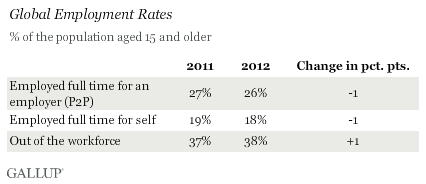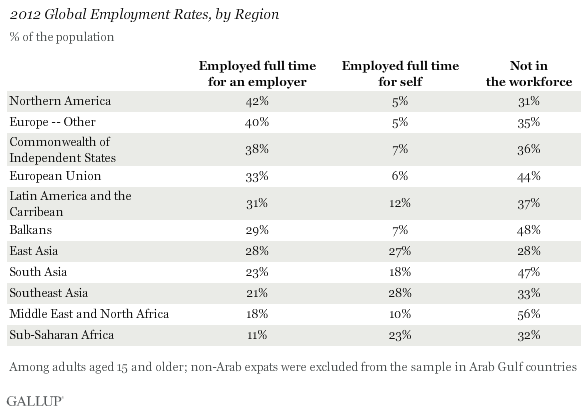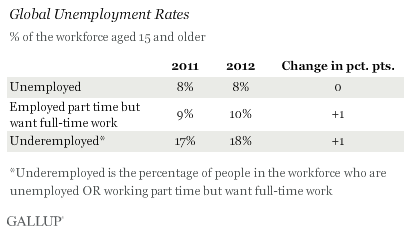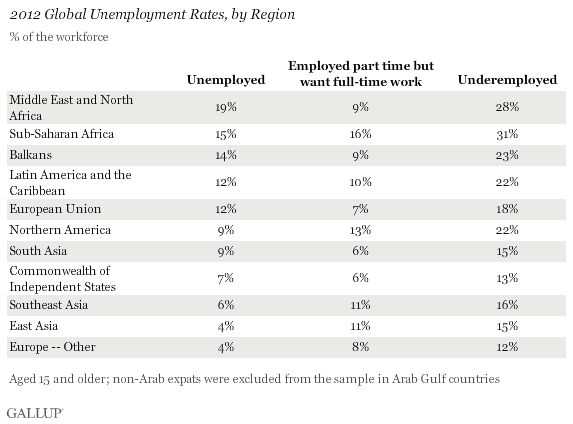WASHINGTON, D.C. -- Twenty-six percent of the world's adult population was employed full time for an employer in 2012, down slightly from 27% a year ago. This decline reverses the upward trend in Gallup's Payroll to Population (P2P) measure since the height of the global recession in 2009.

Gallup's P2P metric estimates the percentage of the adult population aged 15 and older -- not just those currently in the workforce -- who are employed full time for an employer for at least 30 hours per week. Gallup does not seasonally adjust its P2P metric. Gallup does not count adults who are self-employed, working part time, unemployed, or out of the workforce as payroll-employed in the P2P metric.
The percentage of people working full time for themselves was 18% in 2012, a slight decline over 2011 (19%). Thirty-eight percent were out of the workforce (38%), up slightly over 37% in 2011.

P2P Rate Highest in Northern America
On a regional basis, Northern America, made up of the U.S. and Canada, has the highest P2P rate (42%) of all regions in 2012, followed by the group of European countries and areas not in the European Union (40%), which includes Switzerland, Norway, Iceland, and North Cyprus. In both regions, 5% of the population is self-employed, while approximately one-third is not actively participating in the workforce.

At the other end of the spectrum, sub-Saharan African has the lowest P2P rate (11%) followed by Middle East North Africa (MENA) at 18%, which was the only other region to have a P2P rate below 20%.
These results are consistent with Gallup's finding that P2P is highly correlated with GDP per capita. In other words, wealthier countries are more likely to have larger percentages of their population working for an employer, while poorer countries tend to have larger percentages of the population working for themselves.
MENA's relatively low P2P rate is partly attributable to the 56% of the population not participating in the workforce, the highest percentage of all regions. Many people in the region, especially women, voluntarily choose not to work, reducing the number of people who are even interested in full-time employment. Young people in MENA also tend to be more likely to be out of the workforce than their counterparts in other regions, underscoring the challenges facing youth in the MENA region.
At 33%, the European Union's P2P rate falls short of other developed regions. The percentage of people in the EU not participating in the workforce is much higher than in other non-EU European countries and Northern America, which accounts for the difference in the P2P rate.
P2P rates in Latin America, which was not as hard hit as other regions by the global recession, rose three percentage points between 2011 and 2012. This was the largest increase in any region. The EU and Northern America each experienced a one-point increase in P2P, while all other regions remained flat or slightly declined.
High Self-Employment in Asia, Sub-Saharan Africa
Southeast Asia (28%), East Asia (27%), and sub-Saharan Africa (23%) have the highest self-employment rates in the world. Countries in these regions are among the poorest in the world and residents struggle to find decent employment.
In developed countries, self-employment is typically thought of as providing economic energy and fueling growth, but in developing countries, self-employment typically means working a subsistence job that is part of an informal economy. In fact, on a global basis, self-employment has a negative relationship with GDP per capita. There is likely a delicate balance between the ideal percentage of people working for themselves and the percentage of people working for an employer. High percentages of self-employment suggest a lack of good job opportunities. But if these entrepreneurs create jobs, the number of payroll jobs would likely increase.
Global Unemployment Unchanged in 2012
Unlike Gallup's P2P rate, which is a percentage of the total population, unemployment rates are based on a percentage of the workforce. The "workforce" includes adults who are working or actively looking for and available for employment.
Global unemployment in 2012 was 8%, unchanged from 2011, while underemployment increased slightly to 18%, from 17% in 2011. The percentage of people working part time but wanting full-time work, which increased a point, drove this uptick.

MENA had the highest unemployment rate of all regions in 2012, at 19%, followed by sub-Saharan Africa (15%) and the Balkans (14%). Unemployment rates were lowest in East Asia and non-EU European countries at less than 5%.

Underemployment was highest in sub-Saharan Africa and MENA regions, where about 30% of those in the workforce are either unemployed or working part time but looking for full-time work. Gallup's definition of underemployment does not include people who are working below their education or skill level or who are working subsistence jobs.
Non-EU Europe (12%) and the Commonwealth of Independent States (13%) regions had the lowest underemployment rates of all measured in 2012.
Implications
As many countries are still struggling to recover from the global recession, the decline in P2P in 2012 is an unfortunate reversal of the growth seen in 2010 and 2011. For regions such as sub-Saharan Africa and MENA, the relatively low P2P along with high unemployment and underemployment is not a positive sign. Gallup research shows that P2P is highly related to GDP per capita, but perhaps more important is its relationship to individuals' well-being on a daily basis.
Developing countries must strive to create formal job opportunities with desirable working conditions, which will in turn reduce the need for informal subsistence jobs. Developed countries must maintain or grow P2P rates to guarantee residents decent work opportunities and continued economic prosperity and social programs. Gallup will continue to monitor global employment rates in 2013.
For complete data sets or custom research from the more than 150 countries Gallup continually surveys, please contact us.
Survey Methods
Results are based on telephone and face-to-face interviews with 224,975 adults, aged 15 and older, conducted in 2012 in 140 countries and areas. For results based on the total global sample, one can say with 95% confidence that the margin of sampling error is less than ±1 percentage point. For results based on the regional samples, the margin of error ranges from a low of less than ±1 percentage point in Europe to a high of ±2.2 percentage points in non-EU Europe region. For results based on country-level samples, the margin of error ranges from a low of ±1.7 to a high of ±4.2. The margin of error reflects the influence of data weighting. In addition to sampling error, question wording and practical difficulties in conducting surveys can introduce error or bias into the findings of public opinion polls.
For more complete methodology and specific survey dates, please review Gallup's Country Data Set details.

